|
Handheld Nautiz X9
The modern rugged mobile handheld computer has come of age. With ruggedness, Android 7, a bright 5-inch screen, replaceable battery, and industrial-grade scanning.
(by Conrad H. Blickenstorfer; photography by Carol Cotton and Handheld Group; also see Nautiz X9 summary review)
Share on:




On January 10, 2018, the Handheld Group introduced the Nautiz X9, a new member of the company's Nautiz product line that includes both conventional rugged handhelds with keypads as well as toughened-up PDAs that can handle almost anything. The Nautiz X9 is one of the latter, a device that provides all the ease of use of a modern Android device but also offers professional-grade data collection. And it's the company's brawniest and most rugged Android handheld yet. In this report we are analyzing the Nautiz X9 in detail and present our findings and impressions.
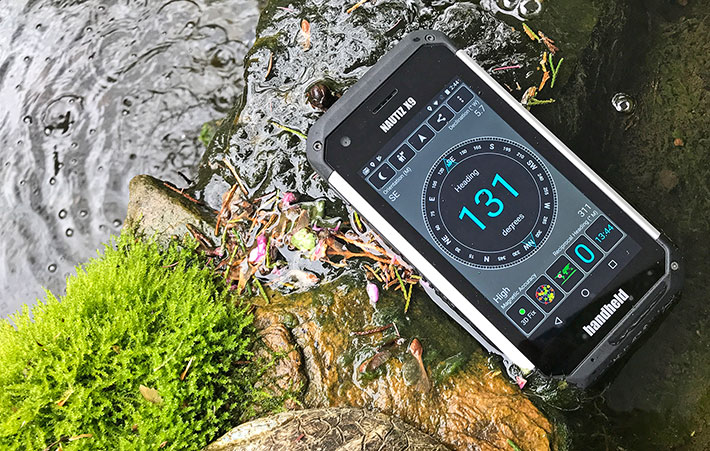
What is the Handheld Nautiz X9 and where does it fit in? It's an industrial-class Android mobile computer measuring 6.6 x 3.3 x 1.00 inches, weighing 13.5 ounces, and having a 5.0-inch capacitive multi-touch screen and an available Zebra SE4710 imager with red aiming LED and direct sunlight reading capability.
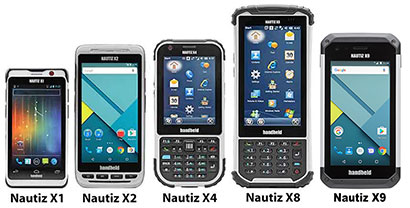 That makes the Nautiz X9 a competent, modern handheld as well as a powerful data collection tool for the shop floor or the field. The image below shows how the new Nautiz X9 fits into the Handheld Group's current Nautiz product line: That makes the Nautiz X9 a competent, modern handheld as well as a powerful data collection tool for the shop floor or the field. The image below shows how the new Nautiz X9 fits into the Handheld Group's current Nautiz product line:
Note that while the Nautiz X1 and Nautiz X2 are pure Android designs, the two keypad devices, the Nautiz X4 and X8, were initially configured for Windows Embedded Handheld but are also available with Android. This means that the company's entire handheld device lineup is now either Android-based or available with Android.
The Nautiz X9, however, takes smartphone convenience in a tough package to a new level. It is a modern Android device, but it is, and looks, intentionally as different from a consumer phone as a modern Sports Utility Vehicle is from a conventional passenger sedan.
In essence, with the modern Android-based Nautiz X9, the Handheld Group also bids farewell to the old Windows Embedded Handheld era. That comes as no surprise after Microsoft gave up on Windows 10 Mobile by putting it into "maintenance mode" in October 2017. We may see future handhelds running full Windows 10, but that's another story.
How to design a tough handheld computer for the field?
Designers of ruggedized handhelds have faced a difficult challenge ever since the birth of the modern smartphone. While smartphones have become an almost unimaginable success, increasing device literacy and technology adoption far 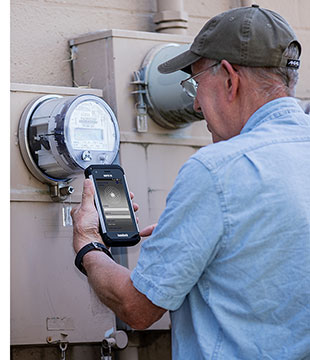 beyond expectation, translating all of that into opportunity for makers of enterprise, industrial and other vertical market handhelds has been tough. beyond expectation, translating all of that into opportunity for makers of enterprise, industrial and other vertical market handhelds has been tough.
That's because smartphones have become so ubiquitous and so powerful that the temptation is to use them where they really should not be used. Because the current smartphone design credo mandates glossy, glitzy devices that are as light and slender as possible. Which makes them uniquely unsuitable for use in the field. Even if they are in a case.
Doesn't that present a great market opportunity for tougher devices that can handle getting dropped, rained on, or whatever else happens to small electronics during a typical day on the job? One would think so, but in reality it's amazingly difficult to succeed in that market. The lure of shiny, trendy stuff is very strong, and few want to pay extra for something that's tougher and won't break as easily.
Add to that the fact that ruggedized phones are tools for real jobs. That can mean industrial grade components that take extra space, larger batteries that can be replaced during a workday, special ports or controls, and perhaps extra hardware and software security provisions. All of that adds extra cost, size and weight.
So in order to have a chance at commercial success, the designers of a rugged handheld device must a) skillfully apply popular design concepts and features onto an underlying much more rugged platform, b) have a credible (if not incredible) spec sheet that gets the job done, and c) sell it at a price that convincingly confirms that its total cost of ownership is indeed lower than the consumer market if-it-breaks-just-get-another approach.
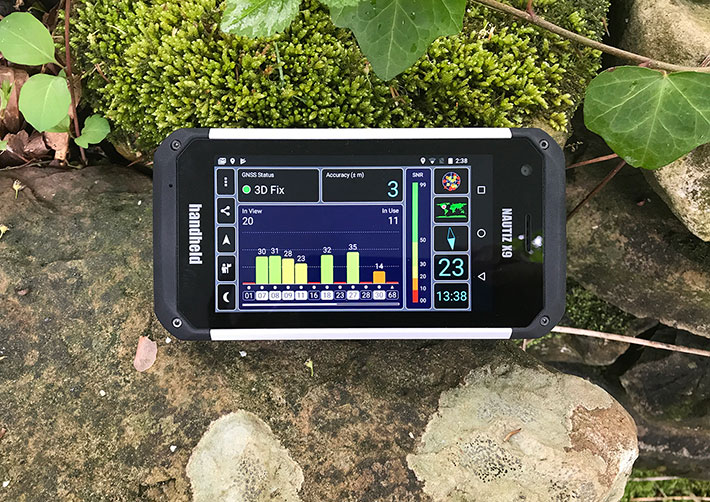
It also helps to have a track record of providing great products and excellent service (see what their customers have to say!), and being able to point at an attractive, cohesive product lineup and clear brand identity, all of which Sweden's Handheld Group has.
I should mention that Handheld Group CEO Jerker Hellstrom is an outspoken advocate of ruggedness from the ground up, rather than just putting consumer products in a case. Both approaches have their supporters, but Handheld's position is very clear. They deal in ruggedness inside and out.
Attractive hardware
So let's look at Handheld's Nautiz X9. Unlike many toughened handhelds that hide their size and bulk behind a consumer smartphone front so as to appeal to customers used to sliver-thin consumer products, the Nautiz X9 presents itself as what it is, a tough, well-protected handheld with a big battery and industrial grade components. The image below shows the Nautiz X9 from the front and back and all sides. It's an honest, purposeful design.
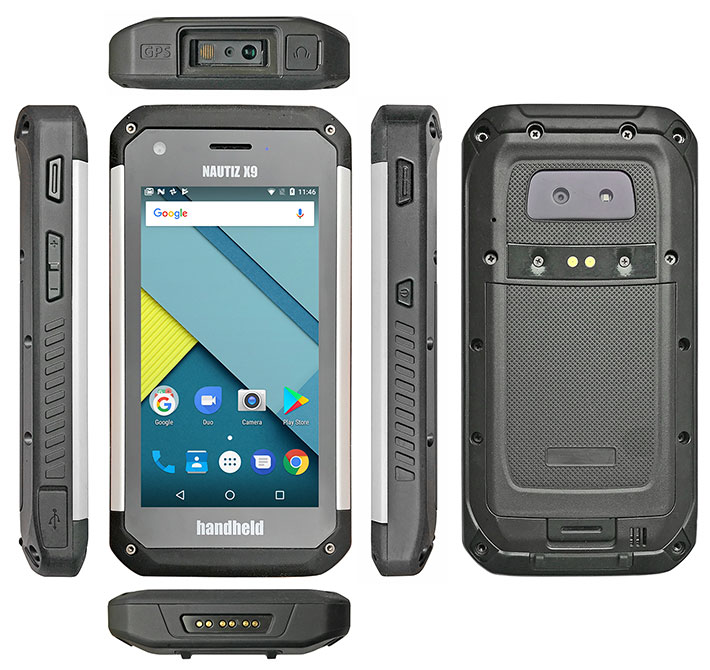
The 6.6 x 3.3 inch footprint of the Nautiz X9 is that of a modern rugged PDA. The Nautiz X9 display measures 5.0 inches diagonally — the biggest display of all of Handheld's Nautiz devices. That's large enough for any task that needs to run on a computer you can still stick into a pocket.
As always, the Handheld Group paid much attention to the look and feel of the product. All Handheld devices, no matter their size or style, share a common design design language and a common color palette. As for the latter, the company's consistent use of their signature light gray and black color scheme enabled the Swedish company to build a cohesive and instantly recognizable brand identity that has undoubtedly contributed to their continuing success. While the Nautiz X9 is mostly black, the two gray inserts along the display instantly mark this as a Handheld Group device.
Unlike some of the company's older handhelds that were conceived for use with Windows Mobile or Windows Embedded Handheld and thus benefitted from a physical keypad, the Nautiz X9 is a pure Android device with no need for physical buttons beyond the basic necessities. On the Nautiz X9, the latter include the power/sleep button, a volume up/down rocker, and a couple of scanner buttons.
What about the standard Android buttons? In Android version 7 "Nougat," there are three, a triangle for step back or ESC, a circle for Home, and a square for tasks/app switching. These three buttons are implemented in software and take up part of the display where they remain visible and available in any application.
While the Nautiz X9 is relatively large, between good ergonomics, grippy materials, and users having adapted to big screen handhelds, the Nautiz X9 feels quite handy. It does weigh 14 ounces, what with its integrated scanner, big battery and rugged build, but it easily fits into most hands and pockets.
The technology under the hood
Assessing the technology and performance of an Android device is quite different from that of a Windows device. Those are fairly easily pegged. After reviewing and benchmarking Wintel devices for decades, one look at the spec sheet is usually enough to get an idea of where a device fits into the performance landscape.
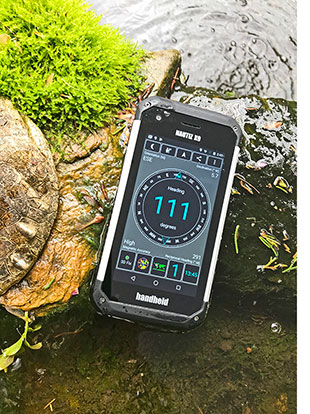 Smartphones and Android-based handhelds may come with processors from Qualcomm, nVidia, Samsung, Texas Instruments and numerous other licensees of the ARM architecture that dominates smartphones. And there seems to be little of the brand loyalty that can be seen in desktops and laptops. Handheld itself uses four different CPU vendors for its five current Nautiz models. Smartphones and Android-based handhelds may come with processors from Qualcomm, nVidia, Samsung, Texas Instruments and numerous other licensees of the ARM architecture that dominates smartphones. And there seems to be little of the brand loyalty that can be seen in desktops and laptops. Handheld itself uses four different CPU vendors for its five current Nautiz models.
 For the Nautiz X9, Handheld chose the 64-bit 1.3GHz quad-core Cortex-A53 MT6735 processor from MediaTek, the same chip already doing duty in the company's Nautiz X2. The MT6735 chip is based on the ARMv8-A instruction set, and the Cortex-A53 is the successor to the popular Cortex-A7. For graphics, the MT6735 also includes an ARM Mali-T720 GPU running at 600MHz. For the Nautiz X9, Handheld chose the 64-bit 1.3GHz quad-core Cortex-A53 MT6735 processor from MediaTek, the same chip already doing duty in the company's Nautiz X2. The MT6735 chip is based on the ARMv8-A instruction set, and the Cortex-A53 is the successor to the popular Cortex-A7. For graphics, the MT6735 also includes an ARM Mali-T720 GPU running at 600MHz.
MediaTek initially introduced the MT6735 as a "WorldMode" smartphone platform designed to allow seamless roaming across high-speed 4G LTE networks for uninterrupted service, and merging 2G, 3G and 4G technologies by supporting FDD/TDD-LTE, WCDMA, CDMA2000, TDS-CDMA, EVDO, GSM, and EDGE.
In our benchmark testing (BaseMark OSII, AnTuTu, and Vellamo), the Handheld Nautiz X9 scored roughly on par with Handheld's Nautiz X2 and the larger Algiz RT7 tablet.
There's 16GB of internal mass storage, which can be complemented via microSDHC card. For navigation, the spec sheet suggests that the Nautiz X9 supports both GPS and GLONASS. Concurrent use of both would mean almost twice the number of available satellites for increased accuracy.
Construction and components of the Nautiz X9
One of our favorite technology sites is fixit.com, the people who built a business around carefully taking electronic devices apart, list what it looks inside, and then rate them in accordance with how difficult it is to repair them. RuggedPCReview also takes gear apart, and has for many years, but we do it to examine whether a product is as tough, rugged and well made inside as it is outside. And also to see how well it is sealed and how we expect it to perform under extreme operating conditions.
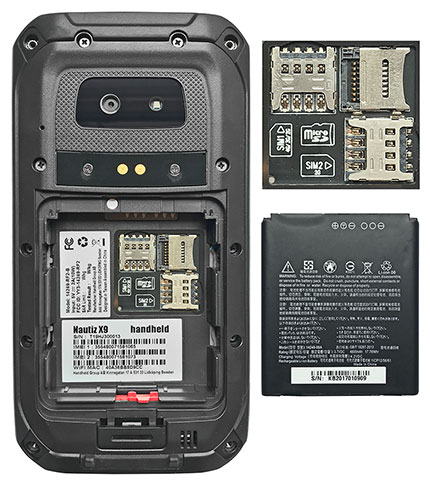 So let's see how the Nautiz X9 is built. Compared to the universal monolithic design of virtually every contemporary smartphone today, the Nautiz X9 features an interesting and nicely contoured style. On the backside it's instantly clear where the camera, flash and speaker are, where the scanner is, and how to access the battery. So let's see how the Nautiz X9 is built. Compared to the universal monolithic design of virtually every contemporary smartphone today, the Nautiz X9 features an interesting and nicely contoured style. On the backside it's instantly clear where the camera, flash and speaker are, where the scanner is, and how to access the battery.
The Nautiz X9's battery is replaceable and externally accessible. The polycarbonate battery compartment cover has its own replaceable black rubber o-ring that neatly sits in a groove and here serves as a friction seal. As long as that o-ring is in good condition, this is a good solution to to keep liquids out. That is imperative here as the inside of the battery compartment is open to the interior of the device.
The battery compartment cover is held in place with a slider lock that clicks into the open or locked positions. The Lithium-Ion battery is a 3.7 Volt, 4,800 mAH design that delivers 17.8 watt-hours. The spec sheet doesn't provide an estimated run-time on a charge but states that the battery allow to "work through the longest shifts." We assume that might mean 10-12 hours.
Inside the battery compartment, located underneath the battery, are the Nautiz X9's dual micro-SIM slots as well as the unit's microSD card slot. Of the two SIM slots, one is for 2G only, one 2G/3G/LTE. The microSD card is of the SDHC variety and can handle storage cards up to 32GB.
In terms of construction, like virtually all PDA-style handheld computers, the Nautiz X9 consists of a front and a back half. The two halves are secured together via four Torx head screws from the front and ten from the rear. Two of the rear screws are hidden, one under in the battery compartment and one underneath a black rubber bumper stuck onto the bottom of the device. Once those screws are all removed, the halves separate easily and there are no wires or cables that could snap or come loose between them. Instead, the Nautiz X9 uses surface mount pressure contacts.
Below you can see the inside of the Nautiz X9, with the topside on the left and the bottom half on the right.

The first thing you notice once the two halves are apart is the long and very intricate o-ring seal that goes around the entire perimeter of the device. It is a modified tongue-and-groove sealing design where the seal sits in its groove and presses against the flat surface on the other half. Somehow, when we took the halves apart, the seal came out of its groove and stuck to the other half of the housing instead. We'd rather see it stay in its groove. On the plus side, note how the sealing groove actually places the screws that hold the device together outside of the seal. This means there is no danger of liquids entering through screw holes, a common issue we see on lesser devices.
The next thing you notice is that the Nautiz X9 has a solid, rigid magnesium frame attached to the front part of its polycarbonate housing, with the LCD screen mounted on one side of the frame and the electronics boards mounted onto the other. The solid metal frame adds weight, but makes the device considerably more rugged; there is no twisting that can work connections loose or put damaging pressure on components or the display.
 Overall, this is a clean and simple layout with nothing in sight that may get in the way or come loose. Instead, there is a number of flat ribbon cables that all securely press into their receiving connectors. Overall, this is a clean and simple layout with nothing in sight that may get in the way or come loose. Instead, there is a number of flat ribbon cables that all securely press into their receiving connectors.
 Unlike mobile computers that do scanning with their onboard camera and a 3rd party app, the Nautiz X9 comes with an integrated industrial-grade miniature scan engine, the Zebra SE4710 1D/2D imager (see SE4710 info). The SE4710 is tiny, measuring just 0.32 x 0.88 x 0.54 inches and weighs less than a fifth of an ounce, which is why there isn't a big scanner bulge on the Nautiz X9. Unlike mobile computers that do scanning with their onboard camera and a 3rd party app, the Nautiz X9 comes with an integrated industrial-grade miniature scan engine, the Zebra SE4710 1D/2D imager (see SE4710 info). The SE4710 is tiny, measuring just 0.32 x 0.88 x 0.54 inches and weighs less than a fifth of an ounce, which is why there isn't a big scanner bulge on the Nautiz X9.
Below you can see some of the interesting details inside the Handheld Nautiz X9. On the left is the tiny vibration motor next to the intricate yellow rubber seal and the magnesium guide for an antenna wire. Next to it the 13mp camera, then an example of the surface mount pressure contacts with pads on one side and tension-loaded contacts ion the other. On the right side the tiny Cirocomm GPS antenna that gives the Nautiz X9 excellent positioning accuracy.

As we've come to expect from Handheld Group devices, the Nautiz X9 is a remarkably clean and logically organized design. Starting with the strong magnesium frame at its core, the custom-designed main and subsidiary boards, and finally the impressive and attractive housing, this latest Nautiz mobile computer looks as good inside as it does outside.
Excellent display
Display technology doesn't get the respect it deserves. It's always all about processors and how much RAM and storage and what OS and which version. That's weird because the quality, technology and sharpness of the display are as much or more important to the overall user experience and user satisfaction.
The 5-inch display on the Nautiz X9 would have been considered very large for a handheld just a few years ago. Remember that the first iPhone launched with a 3.5-inch screen in 2007, selling tens of millions, and it wasn't until 2012 that Apple introduced the iPhone 5 with a larger 4.0-inch screen. Since then, of course, the consumer smartphone screen sizes have been growing ever larger.
As is, the Nautiz X9 display looks just about right — not so large as to make the device bulky but large enough to easily work on. The screen's 1280 x 720 pixel resolution makes for 294 pixels per inch. That's very crisp and actually sharper than any Apple iPad and MacBook. It's also much sharper than the original iPhone (163 dpi), and even the 5K Retina iMac27 this review was written on (218 dpi). And it's an IPS (In-Plane Switching) screen, which means it has perfect viewing angles from all directions, without any color or contrast changes.
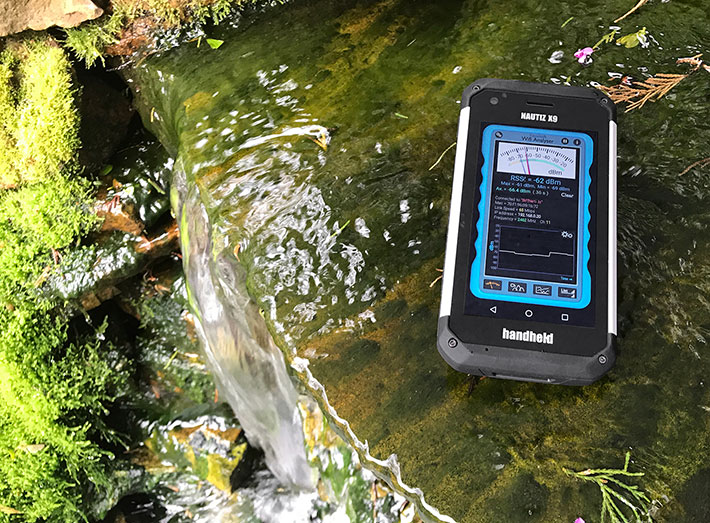
The pictures below show an outdoor comparison between the Handheld Nautiz X9 and an iPhone 7 Plus, both at maximum brightness. Apple's 7 Plus is said to have a maximum screen brightness of around 700 nits. The Nautiz X9's specs don't provide a nits rating; we'd estimate about 450 nits. Interestingly, under most conditions, the Nautiz X9 looks as, or almost, as bright. The image below was taken in late April, early afternoon, on an overcast day.
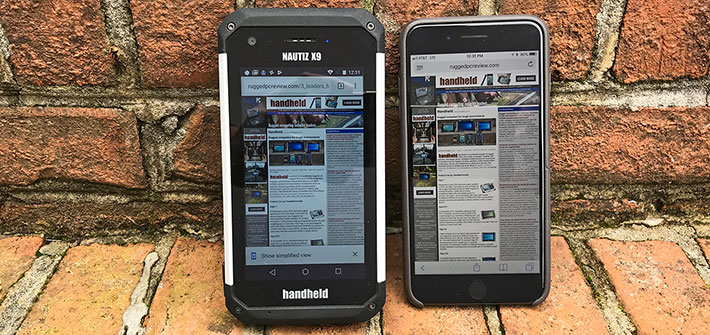
In the second picture below, we show the two devices under very different lighting conditions. On the left, they are facing the open sky. Again brightness appears almost the same, with the Nautiz having a slightly blueish hue and the iPhone a more yellowish one. The picture on the right is indoors in a darkish room. Here, the hues are more pronounced, and brightness seems again quite similar.
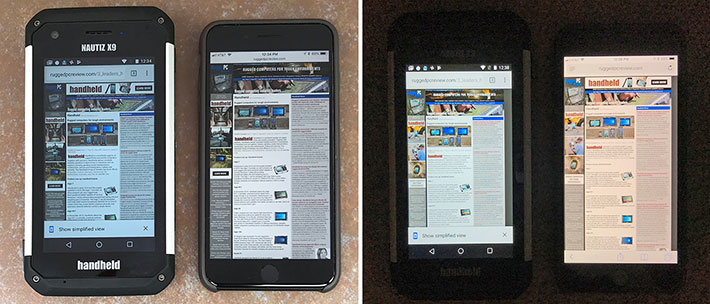
Both displays are glossy, so there will be reflections outdoors. Most smartphone and tablet users have learned to live with that. The image below emphasizes the point. A few degrees can make the difference between a strong, clear picture and substantial reflection. That is the way it is with today's available technology.
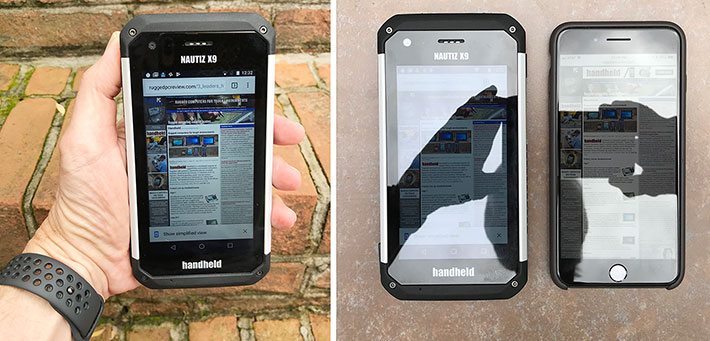
An often overlooked quality of a good display is its ability to be viewed from any angle. Older screen technologies suffered from narrow viewing angles either horizontally or vertically or both, often accompanies by dramatic brightness color or contrast changes as viewing angle varied. The Nautiz X9 doesn't suffer from any of this. It offers virtually perfect viewing angles from all directions, without any changes in brightness or colors.
Given that iPhones aren't rugged device specifically designed for outdoor use, shouldn't the Nautiz X9 have beaten it outright? No. There are technology limits, and hanging with an iPhone and at times beating it is high praise indeed.
Camera for use on the job
Only a few years ago it seemed doubtful that cameras built into rugged handhelds would ever become as good as the ones in the Nautiz X9. And yet, that's what has happened. Integrated cameras, tiny though they are, have gone from terrible and essentially useless to amazingly good in just a brief period of time. Here at RuggedPCReview.com, we've been doing virtually all of our product review photography with smartphones now. Between the big display, the great software, the easy communication and uploading, and the good quality, it's just so much more convenient. More and more field service and other professionals are doing likewise. No, cameras built into handhelds are still no replacement for a digital SLR. But if they are as good as those in the Nautiz X9, they get most jobs done.

The Nautiz X9's integrated documentation camera can take images with resolutions of up to 13 megapixel. It also has an LED illuminator that you can turn on and off via software to add extra light. It's not a flash in terms of power, but certainly helps taking better pictures in marginal lighting conditions.
 The default Camera app that came with our review unit allows shooting in 1, 2, 4, 6, 9, and 13 megapixel stills, with the highest resolution in 4:3 aspect ratio and the others in 16:9. Video can be set to low, medium, high and fine quality. Since settings in the default camera app are quite limited, we suggest downloading a good third party camera app (we recommend Mark Harman's excellent and free Open Camera app from the Google Play store). The default Camera app that came with our review unit allows shooting in 1, 2, 4, 6, 9, and 13 megapixel stills, with the highest resolution in 4:3 aspect ratio and the others in 16:9. Video can be set to low, medium, high and fine quality. Since settings in the default camera app are quite limited, we suggest downloading a good third party camera app (we recommend Mark Harman's excellent and free Open Camera app from the Google Play store).
See example default camera app user interface screen snaps to the right.
In the default camera, there are 14 screen settings, three flash settings, 8 white balances, you can turn HDR and GPS location on or off, do 2 or 10 second timers, and change exposure from -3 to +3. Users can also set sharpness, hue, saturation, brightness and contrast to low, medium or high. Speed demons will like the zero shutter delay setting. There are settings for face detection, anti-shake, shutter delay, 40 or 99 shots continuous, ISO from 100 to 1600, etc. There is a panorama mode and a picture-in-picture mode in addition to the standard mode.
Users can do basic editing right on the Nautiz X9. There is a wealth of functions available, including 14 color effects, cropping, straightening, different aspect ratios, and as well as numerous light and color controls. The camera app can also send images to Messaging, email, Skype, OneDrive or whatever other social media apps you have on the device.
Below are some sample shots we took with the documentation camera. Click on the picture to get a full-size version.
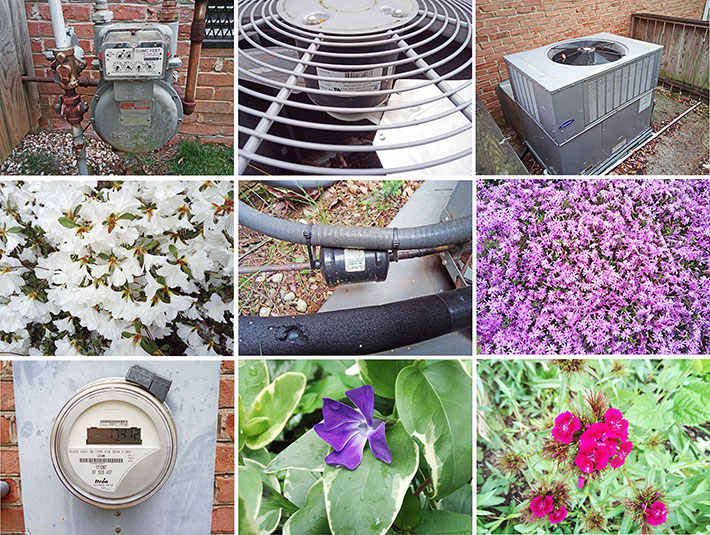
Overall, the Nautiz X9 camera is capable of taking very good pictures, much better than we generally see from industrial handhelds. There is very good sharpness and image detail, and virtually none of the massive compression that in the past used to render pictures from such integrated cameras useless. The lag and occasional hiccups that made older onboard integrated cameras nearly useless are also completely gone.
Video is also better than what we've come to expect from cameras integrated into rugged devices. Frame rate and focussing are quick and the camera doesn't fall behind. The maximum 1920 x 1080 pixel 1080p recording format is very useful. We wish, though, that recording size could be selected directly, rather than via the "low, medium, high and fine" quality options.
The video to the right was taken with the Nautiz X9 camera. It's an example of a clip that an automotive mechanic or tuner might shoot as an attachment to a work order.
Note that the camera applications that come with mobile operating systems are often replaced with third party applications optimized for certain tasks, or developers and systems integrators include camera and video functionality directly into custom applications.
In summary, the still image and video functions of the Nautiz X9 are good enough for many work-related documentation jobs.
Ruggedness: no need for a protective case
The Nautiz X9 was designed to be taken along, and used, on the job without needing extra protection in the form of a case. To that extent, it's sturdy enough to never bend or twist, it doesn't have any glossy and scratch-prone metal surfaces, and the device is grippy enough to greatly lessen the chance of it slipping out of your fingers. Further, the very slightly raised bezel protects the strengthened glass display in case of a drop.
According to its specs, the Nautiz X9 can handle a very wide operating temperature range from -4 to 131 degrees Fahrenheit (-20 to 55 Celsius). That's good enough for most deployments, except for extremest heat or cold. It carries IP67 sealing where the "6" means the computer is totally protected from dust, and the "7" that it can handle full immersion into water down to one meter. The Nautiz X9 also passed the MIL-STD-810G 516.6 Procedure IV test of 26 drops from a height of four feet to concrete. What does all this mean?
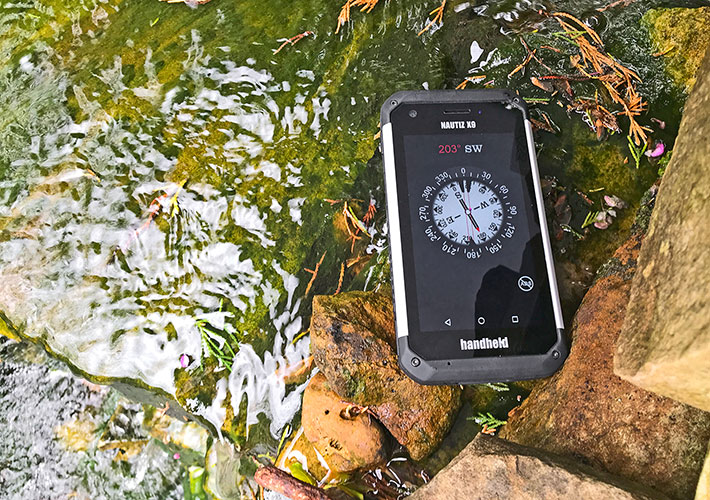
As far as operating temperature goes, the device can be used in most environments where someone would be expected to work with a computer. The folks at the Handheld Group's native Sweden know a thing or two about ice and snow and working in the cold, so we're sure they have low temperature suitability covered.
 As far as the Nautiz X9's ability to handle 5-foot drops go, that's better than four feet the military standard suggests in its testing. Why is that important? Four feet is what rugged tablets and laptops must be able to handle because four feet is about the height they may fall while being used in a standing position. As far as the Nautiz X9's ability to handle 5-foot drops go, that's better than four feet the military standard suggests in its testing. Why is that important? Four feet is what rugged tablets and laptops must be able to handle because four feet is about the height they may fall while being used in a standing position.
Anything, however, that can also be used as a phone, and the Nautiz X9 is in that category, may easily be dropped from five feet when the device is being used for a call. And that's why the five feet drop spec is important.
IP67 protects a device even against immersion into water to a depth of about three feet. We consider that a very good thing and pretty much mandatory for a handheld device that will be used in the field. Why? Because there's always the chance that it will fall into a puddle or get soaked in some other way. Knowing that it can handle that, and more, brings peace of mind. And do realize that it's more involved to seal a device with multiple openings and a large, replaceable battery than it is to seal one that doesn't even have a headphone jack. As is, we had our review Nautiz X9 sitting in water and, as expected, it neither leaked nor stopped operating normally.
Vibration resistance was tested as described in MIL-STD-810G, Method 514.6, Procedures I & II, for general vibration in a fixed mounting and a loose cargo test, but there is no detailed description. This would be good to have as many Nautiz X9 devices will likely see their share of being rattled and bopped around. The Nautiz X9 can handle operating altitudes up to 15,000 feet. This is relevant not only for use in mountainous areas, but also in unpressurized airplanes. The device was also tested according to MIL-STD-810G, Method 507.5 for humidity resistance.
While some customers will probably want to see actual lab reports with more specific detail, and we'd like to see the Handheld Group take a more aggressive stance in some of its ruggedness ratings, the overall impression of the Nautiz X9 is that it's indeed a remarkably rugged device that is capable of handling a substantial degree of abuse.
Summary: Handheld Group Nautiz X9
What, overall, does that make the Handheld Group's Nautiz X9? In essence, it's the modern rugged handheld come of age, having found its own form, style, and purpose. It's handy, useful, and up-to-date in every respect. There's one less reason to use brittle consumer tech on the job, even if it's in a bulky case.
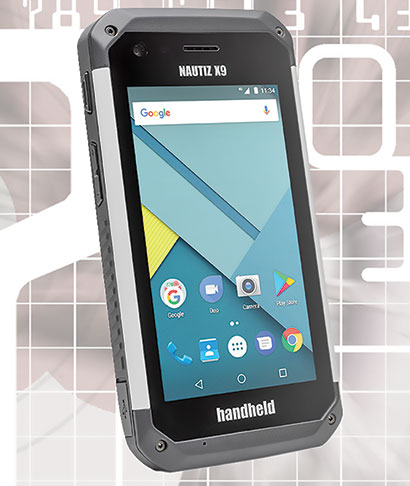 With a footprint roughly the same as that of the iPhone 8 Plus, the attractively styled Nautiz X9 remains manageable in size and weight. It's quite pocketable and gets high marks both in ergonomics and functionality. With a footprint roughly the same as that of the iPhone 8 Plus, the attractively styled Nautiz X9 remains manageable in size and weight. It's quite pocketable and gets high marks both in ergonomics and functionality.
The bright and vibrant 5-inch sunlight-viewable capacitive multi-touch screen IPS display is very sharp and offers perfect viewing angles from all directions, without any color or contrast shifts. The touch screen is as quick and responsive as on any smartphone.
Unlike consumer smartphones, the Nautiz X9 is more than rugged enough to be used in any environment, without even needing a bulky case. The onboard micro-USB and 3.5mm audio ports are protected by unobtrusive, well-fitting plugs. The battery is replaceable in seconds, and the Nautiz X9 has a microSD card slot.
The unit provides excellent wireless functionality (WiFi, WWAN, Bluetooth, GPS, NFC). Industrial-grade integrated scanning is available also — a much more powerful solution than using an app with the built-in camera. Speaking of which, the integrated 13-megapixel documentation camera is capable of very good images and video, and there is also a user-facing camera.
With the Nautiz X9, the Handheld Group gives enterprise users an all-in-one Android 7-based mobile computer that can handle all the tasks of a day's work. One with built-in ruggedness that allows it to be used anywhere from a warehouse to challenging outdoor environments with moisture, dust, extreme high or low temperatures and potential drops. And the price for all of this? No more than a premium smartphone. -- Conrad H. Blickenstorfer, May 2018
Handheld Group Nautiz X9 Specifications:
| Status |
Added 01/2018, full review 05/2018
|
| Type |
Rugged Android PDA
|
| Processor |
MediaTek MTK MT6735 quad-core processor (4 x ARM Cortex-A53, 28nm) |
| Processor speed |
1.30GHz |
| OS |
Android 7.0 "Nougat" (GMS) |
| Graphics |
Mali-T720 |
| RAM/ROM |
2GB RAM/16GB Flash |
| Display type |
Sunlight-readable TFT with strengthened glass |
| Display size and resolution |
5.0"/1280 x 720 pixel (294 ppi)
|
| Digitizer/Pens |
Projected capacitive multi-touch |
| Keyboard |
Onscreen + 4 function keys + scan buttons |
| Expansion |
1 x microSDHC (32GB), 2 x SIM |
| Housing |
PC+ABS polymer over magnesium frame |
| Operating temperature |
-4° to 131°F (-°20 to 55° Celsius)
|
| Shock |
26 5-foot drops per MIL-STD-810G, Method 516.6, Procedure IV
|
| Vibration |
MIL-STD-810G testing
|
| Enclosure Class |
IP67, MIL-STD-810G, IEC 60529 |
| Altitude |
15,000 feet (4,572 meters)
|
| Hazardous materials |
unknown |
| Size |
6.6 x 3.3 x 1.0 inches (166 x 86 x 25 mm)
|
| Weight |
14 ounces (398 grams) as tested
|
| Power |
3.7V, 4,800mAH, 17.76 whr Li-Ion
|
| Camera |
Rear-facing 13mp auto-focus camera with LED flash, front-facing 2mp
|
| Scanning |
Optional 1/2D Zebra SE4710
|
| Sensors |
G-sensor, ambient light, proximity, pressure, magnetometer, gyroscope
|
| Interface |
Micro USB 2.0, High-speed / OTG, 3.5mm audio, dock
|
| Communications |
Dual-band 802.11a/b/g/n WiFi, Bluetooth 4.0 LE, WWAN (GSM/HSPA+, 4G LTE), GPS/Glonass
|
| Price |
Starts at US$999
|
| Product brochure |
 Nautiz X9 brochure Nautiz X9 brochure |
| Web page |
Handheld Group Nautiz X9 web page |
| Contact |
Handheld Group AB
Kinnegatan 17A
531 33 Lidköping, Sweden
Tel: +46 (0) 510 54 71 70
Fax: +46 (0) 510 282 05
Web: www.handheldgroup.com
Email: info at handheldgroup.com
|
HHCS Handheld USA Inc.
33870 SE Eastgate Circle
Corvallis, OR 97333, USA
Tel: (541) 752-0313
Fax: (541) 752-0338
Web: www.handheld-us.com
Email: info at handheld-us.com
|
|
(copyright 2018 RuggedPCReview.com)
|









 That makes the Nautiz X9 a competent, modern handheld as well as a powerful data collection tool for the shop floor or the field. The image below shows how the new Nautiz X9 fits into the Handheld Group's current Nautiz product line:
That makes the Nautiz X9 a competent, modern handheld as well as a powerful data collection tool for the shop floor or the field. The image below shows how the new Nautiz X9 fits into the Handheld Group's current Nautiz product line:
 beyond expectation, translating all of that into opportunity for makers of enterprise, industrial and other vertical market handhelds has been tough.
beyond expectation, translating all of that into opportunity for makers of enterprise, industrial and other vertical market handhelds has been tough.


 Smartphones and Android-based handhelds may come with processors from Qualcomm, nVidia, Samsung, Texas Instruments and numerous other licensees of the ARM architecture that dominates smartphones. And there seems to be little of the brand loyalty that can be seen in desktops and laptops. Handheld itself uses four different CPU vendors for its five current Nautiz models.
Smartphones and Android-based handhelds may come with processors from Qualcomm, nVidia, Samsung, Texas Instruments and numerous other licensees of the ARM architecture that dominates smartphones. And there seems to be little of the brand loyalty that can be seen in desktops and laptops. Handheld itself uses four different CPU vendors for its five current Nautiz models.
 For the Nautiz X9, Handheld chose the 64-bit 1.3GHz quad-core Cortex-A53 MT6735 processor from MediaTek, the same chip already doing duty in the company's Nautiz X2. The MT6735 chip is based on the ARMv8-A instruction set, and the Cortex-A53 is the successor to the popular Cortex-A7. For graphics, the MT6735 also includes an ARM Mali-T720 GPU running at 600MHz.
For the Nautiz X9, Handheld chose the 64-bit 1.3GHz quad-core Cortex-A53 MT6735 processor from MediaTek, the same chip already doing duty in the company's Nautiz X2. The MT6735 chip is based on the ARMv8-A instruction set, and the Cortex-A53 is the successor to the popular Cortex-A7. For graphics, the MT6735 also includes an ARM Mali-T720 GPU running at 600MHz.
 So let's see how the Nautiz X9 is built. Compared to the universal monolithic design of virtually every contemporary smartphone today, the Nautiz X9 features an interesting and nicely contoured style. On the backside it's instantly clear where the camera, flash and speaker are, where the scanner is, and how to access the battery.
So let's see how the Nautiz X9 is built. Compared to the universal monolithic design of virtually every contemporary smartphone today, the Nautiz X9 features an interesting and nicely contoured style. On the backside it's instantly clear where the camera, flash and speaker are, where the scanner is, and how to access the battery.

 Overall, this is a clean and simple layout with nothing in sight that may get in the way or come loose. Instead, there is a number of flat ribbon cables that all securely press into their receiving connectors.
Overall, this is a clean and simple layout with nothing in sight that may get in the way or come loose. Instead, there is a number of flat ribbon cables that all securely press into their receiving connectors.
 Unlike mobile computers that do scanning with their onboard camera and a 3rd party app, the Nautiz X9 comes with an integrated industrial-grade miniature scan engine, the Zebra SE4710 1D/2D imager (
Unlike mobile computers that do scanning with their onboard camera and a 3rd party app, the Nautiz X9 comes with an integrated industrial-grade miniature scan engine, the Zebra SE4710 1D/2D imager (





 The default Camera app that came with our review unit allows shooting in 1, 2, 4, 6, 9, and 13 megapixel stills, with the highest resolution in 4:3 aspect ratio and the others in 16:9. Video can be set to low, medium, high and fine quality. Since settings in the default camera app are quite limited, we suggest downloading a good third party camera app (we recommend Mark Harman's excellent and free Open Camera app from the Google Play store).
The default Camera app that came with our review unit allows shooting in 1, 2, 4, 6, 9, and 13 megapixel stills, with the highest resolution in 4:3 aspect ratio and the others in 16:9. Video can be set to low, medium, high and fine quality. Since settings in the default camera app are quite limited, we suggest downloading a good third party camera app (we recommend Mark Harman's excellent and free Open Camera app from the Google Play store).


 As far as the Nautiz X9's ability to handle 5-foot drops go, that's better than four feet the military standard suggests in its testing. Why is that important? Four feet is what rugged tablets and laptops must be able to handle because four feet is about the height they may fall while being used in a standing position.
As far as the Nautiz X9's ability to handle 5-foot drops go, that's better than four feet the military standard suggests in its testing. Why is that important? Four feet is what rugged tablets and laptops must be able to handle because four feet is about the height they may fall while being used in a standing position.
 With a footprint roughly the same as that of the iPhone 8 Plus, the attractively styled Nautiz X9 remains manageable in size and weight. It's quite pocketable and gets high marks both in ergonomics and functionality.
With a footprint roughly the same as that of the iPhone 8 Plus, the attractively styled Nautiz X9 remains manageable in size and weight. It's quite pocketable and gets high marks both in ergonomics and functionality.
